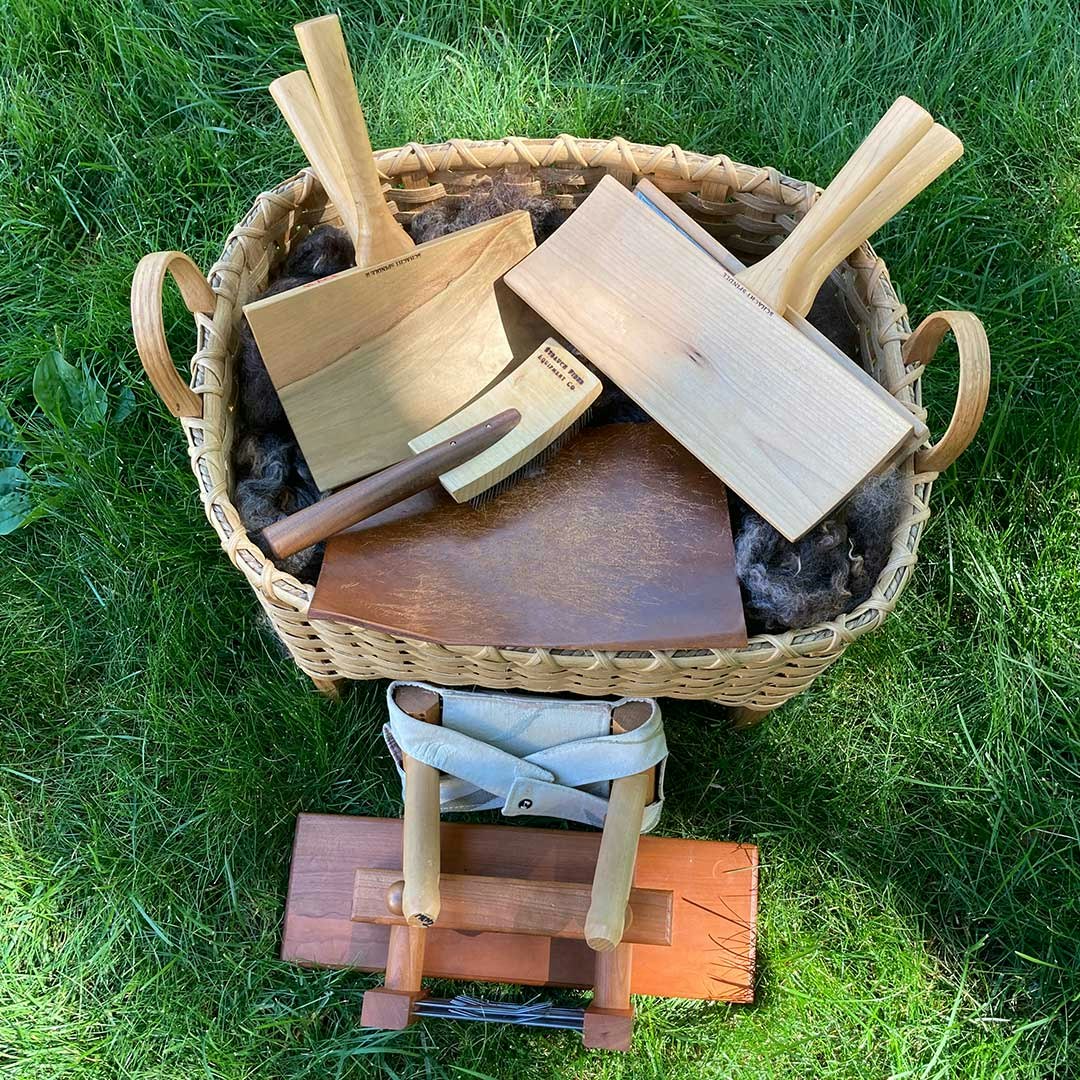When I started spinning yarn, I had one spindle and no fiber-prep tools. Eventually, I got a spinning wheel and a pair of handcards, and later, I bought and sold more wheels, collected spindles of all types and shapes, and obtained a variety of fiber-preparation tools. While I enjoy using all of my tools, I was just as much of a handspinner with one spindle, preparing my fiber by hand, as I am now with a wide array of options for spinning and fiber preparation.
Tools do not a spinner make.
Now that I have said that, let me say that there are several reasons a handspinner might want a collection of tools.
Tools for Spinning
My spinning-tool flock currently includes a great wheel, an e-spinner, a treadle wheel, and a large collection of spindles. One benefit of having so many spinning tools at my disposal is that by changing the tool and technique, I can spin a number of different yarns, and I like the diversity. The biggest thing for choosing spinning tools is to find the one that works best for you. For example, I have had several treadle wheels over the years but have sold most of them.
The great wheel, I’ll admit, is just for fun. I enjoy spinning on it, always wanted one, and once I had the space, kept my eye out for one. Spin off the Quill’s tip using a long draw for a lofty yarn.
The e-spinner is the newest addition to my spinning-tool collection. Several of my friends have them, allowing me to try various makes and models and find which one worked best for me. I have arthritis, and sometimes, treadling on a wheel can be painful. Other times, I want the ease and mobility of travelling with a spinning wheel; the e-spinner takes up very little space. Also, with this compact wheel, I can spin all the fibers and yarn types I want.
My treadle wheel is my personal go-to spinning tool, and I do the vast majority of my handspinning on it. I enjoy treadling while I spin and appreciate the control I have, slowing my treadling almost without thought while I manage a slub or rearrange my fiber. For responsiveness, my treadle wheel wins out over all other spinning tools I have tried.
Spindles remain my first love, and I use them frequently for spinning projects large and small. They take up little space, are friendly to the wallet, and come in a wide variety of shapes and sizes to suit any spinner or yarn. I reach most often for a low-whorl spindle but have mid- and high-whorl spindles, as well. I usually spin suspended but will also use them grasped in hand or supported. Spindles travel well, and occasionally, you may find me spinning on one while I walk.

Devin samples each fleece and fiber to see which fiber prep works best—carding, combing, or flicking.
Fiber-Preparation Tools
I have wool and cotton handcards, flickers, and various combs for preparing fiber. I use all of these tools, in addition to using only my hands, to prepare fiber for spinning. Having a variety of fiber-prep tools allows me to experiment and sample when trying a new fiber or deciding how to spin a fleece. Having a variety of fiber-prep tools allows me to sample all preps and make an informed decision. I sample each fleece or fiber I am working with to see which yarn I like best.
My first fiber-prep tool was a dog brush, which I soon replaced with a proper flick carder to open up locks of wool. This allows me to spin from a more aligned preparation, which is especially useful when working with a fleece or dyed locks with multiple colors and gives the spinner more control over how the color is used in the yarn.
I quickly added a pair of handcards to my tool stash, and later, a drumcarder for creating batts. A versatile tool, handcards make rolags, punis, or small batts. Handcarded rolags are a favorite prep of mine for spinning with a long draw. My drumcarder is ideal for carding large amounts of wool, blending colors, and blending fibers. I do not have a blending board, but that can also be used for blending fibers and producing punis. These tools produce a prep that is suited to making lofty and bouncy yarns when spun with a long draw. When spun with a more managed drafting style, such as a short-forward draw, these preparations produce a less lofty yarn but one that still emphasizes warmth.
Eventually, I acquired a set of combs for preparing top. I use combs, or a hackle, to blend and align the fibers and to remove shorter fibers or any second cuts. To create a true top, the fiber is drawn and attenuated off the combs with a diz, but you can also draw it off without a diz, using your hands, or even spin directly off of the comb. Combs are fantastic for removing vegetable matter from fleece. This fiber prep is suited to using short-forward or short-backward draw and making a smooth yarn, emphasizing luster and shine. If you spin long draw from the fold, you can add loft and bounce to yarn spun from top.
It’s perfectly reasonable to add and subtract tools as your needs and spinning practice change. As my spinning practice grows and changes, so will my tool collection.
Devin Helmen has been immersed in fiber since learning to spin at age 8. They spin, knit, and weave in beautiful Minnesota. Devin enjoys writing and teaching about fiber arts and has a passion for spindles and everyday textiles. They blog, intermittently, at www.afewgreenfigs.blogspot.com.

